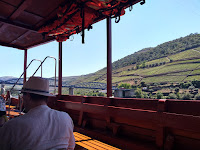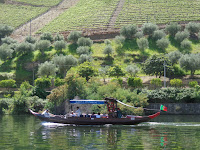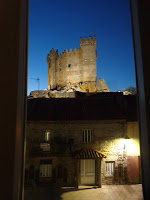The second part of my cycling tour took me from medieval villages to wine country. I was already at a higher altitude, so my fourth ride was supposedly mostly descent, but I did have to climb some at the start. But as I passed grape vines in the panorama, I didn't mind (top left). And it certainly wasn't a bother to share a bed of wildflowers with some bees when I stopped for a snack (top right). I knew it was all downhill when I saw Douro Valley in the distance (bottom left). The next day's route included a visit to Pinhao (bottom right), but I was feeling invigorated enough that I took a detour there, so I could take it easy on my final ride.
Plus, I wanted to make sure that I had time to take a boat tour along the Douro River (top left). It's easy enough to see the waterway by bike or car, but it seemed romantic to go by rabelo, the boats once used to transport port barrels downstream (top right). I only took an hour-long cruise, halfway upstream past some remote vineyard estates (bottom left). A couple times, we were passed by larger ships doing multi-day excursions the length of the river (bottom right).When I got back to dock, I took a short stroll through the town, pausing to look at the mosaics on the train station, another convenient way to reach the region (top left). I made a more leisurely stop at Xtreme Douro, where I had my first pasteis de nata with a glass of white (top right). Only one glass, so I could make the 10-mile ride to Hotel Folgosa, where I was given a generous welcome gift of tawny port (middle left). The village doesn't have much in the way of restaurants, so the hotel directed me around the corner to neighborhood hangout La Bamba, which offered a liberal helping of local specialties, including olives and crusted cod (middle right). Legs tired and belly full, I fell asleep with my balcony door open, enjoying the lapping of the river and the twinkling of Covelinhas (bottom).
Quite frankly, I was a bit frightened of my fifth and final ride because I knew that, from my hotel, there was nowhere to go but up. Actually, I could have cheated and skipped the climb, but the uphill grade turned out to be not too overwhelming (top). And downtown Tabuaco was a pleasant midway point in the loop, with its refreshingly green park (middle left), adjacent to yet another pillory surrounded by more mosaics (middle right). The view wasn't spectacular but the beer was cold at Cascata Bar (bottom left). The drink and some hail marys fueled me up one more hill before I coasted back down to the valley (bottom right).
My package included a winery tour, but I had some time to kill before my scheduled visit, so I backtracked along the river to Foz do Tavora, a riverside bar featuring reds from Quinta Do Pego (top left). I had just enough time for a glass before I returned to Quinta do Tedo (top right). The vineyard, conveniently located along a national trail, is named for a native bird (middle left). Apparently, they are small and hard to spot, so I focused on the winery's other fauna: a flock of snoozing farm dogs (middle right). Before I could pet them awake from their slumber, the tour began, first with a demonstration of historical methods of grape collection (bottom left). Then we were allowed to view the old, wooden vats still used to ferment the wine (bottom right).
But let's be honest, I was there for the booze. I heartily enjoyed my trio of ports and even snagged the leftovers of a less-imbibing tablemate (top left). That evening, the decadence continued, albeit sans dining companion, at DOC, where I indulged in a white-port martini to start off my meal, alongside some complimentary curry popcorn (top right). I opted for the "essence" tasting menu, which included seven dishes. All of them were Instagram-worthy, but I will share just two of my favorites: raw egg and alheira sausage adorned to look like a forest floor (bottom left) and lemon cake and sorbet with honeycomb (bottom right).
I guess, technically, my last ride was to Regua, my designated pickup point. But the 10 miles downhill along the river hardly seemed strenuous (top left), especially considering it ended at a museum about port (top right). The Douro Museum was more academic than I expected. The standard tour takes you past restoration rooms (middle left), where workers preserve wine-related records in climate-controlled archives (middle right). The visit concludes on a riverview patio, which some resident roosters have made home (bottom left). Immune to their crowing, I enjoyed my free glass of port, relishing the last moments of an inspiring respite (bottom right).













































































